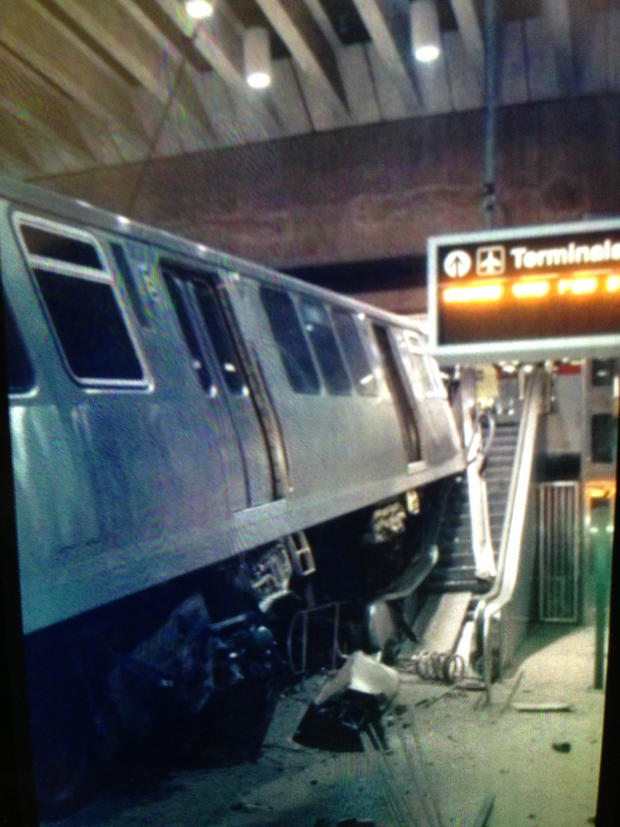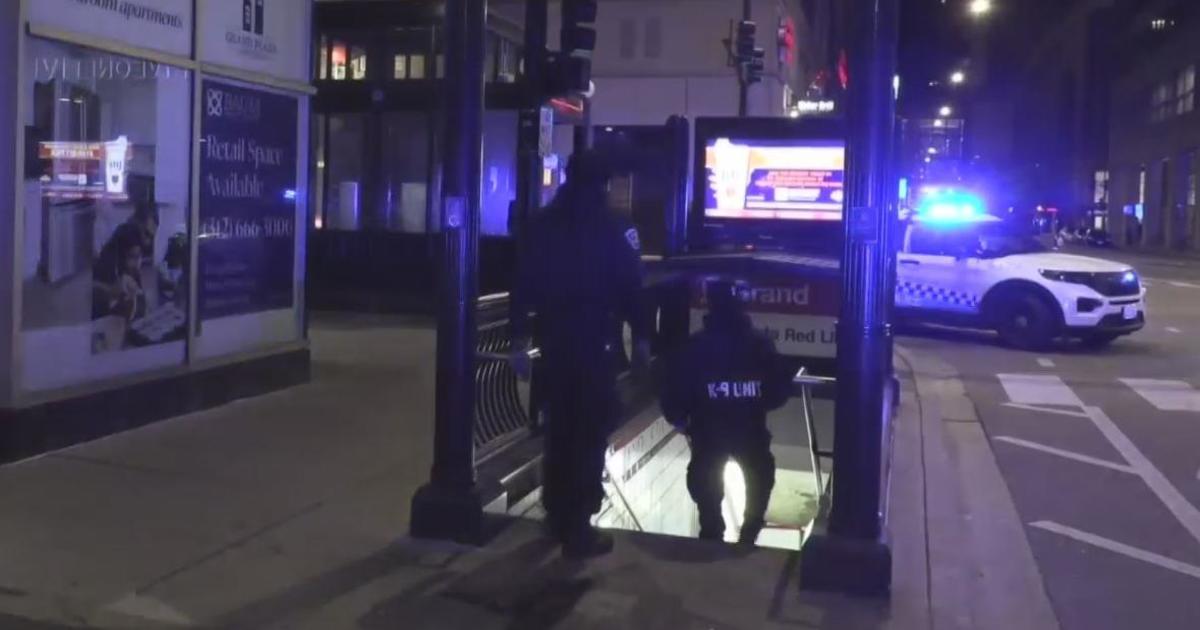NTSB: Automated Stopping System Activated Before Blue Line Crash
Updated 03/25/14 - 4:21 p.m.
CHICAGO (CBS) -- Federal investigators said an automated braking system known as a "track trip" activated just before a CTA Blue Line train derailed at O'Hare International Airport and plowed into an escalator, but it's not clear if the system applied the brakes as quickly as it should.
NTSB investigator in charge Ted Turpin said a six-member team still has lots of evidence to gather before determining the cause of the derailment. Tuesday afternoon, they will interview the operator who was at the train's controls.
Turpin would not speculate how soon the damaged train could be removed, and the O'Hare station could reopen.
He said a "track trip" system at the O'Hare terminal did activate as the train was pulling into the station around 2:50 a.m. Monday, and brakes were applied, but investigators aren't sure yet if that system kicked in exactly when it should.
"Whether it did it in time or not — that's an analysis we have to figure out," Turpin said.
Automatic Stopping System Activated, But Didn't Stop Blue Line Train
Turpin said NTSB investigators have determined the train was going 25 to 26 miles per hour as it pulled into the center platform at the O'Hare station, which is not unusual for a train approaching the station.
Investigators have yet to conduct a thorough examination of the brakes themselves.
Turpin said investigators have reached out to the operator to schedule an interview about what happened, and will speak to her at 1 p.m. Tuesday. Sources said she already has told union officials she briefly fell asleep before the train jumped the tracks.
NTSB and CTA officials have said an eight-car train failed to stop as it pulled into the O'Hare station, and jumped the tracks, went onto the platform, then went up the escalator, stopping just short of the turnstiles.
PHOTOS: More pictures from the scene of the crash.
The train plowed through a bumper stop at the end of the tracks. Robert Kelly, president of Amalgamated Transit Union Local 308 said bumper stops are not designed to stop a train traveling at anything much faster than a slow crawl.
"That bumper post probably is not going to stop eight cars," Kelly said. "You've got seven cars pushing this thing, and the bumper post, had it gone back against the wall, might have stopped it, because now you've got a wall and a post. But as I said, from what I understand, the bumper post leaned, and it became a catapult."
Two sources told CBS 2 that the operator has signed a statement acknowledging she did doze off just before the crash.
Turpin said, if the operator's hand came off the controls, automated systems should have stopped the train.
"The train will stop automatically if the operator takes their hand off the handle. It's spring-loaded, and it goes to a stop position," he said.
NTSB investigators have contacted the operator to conduct an interview on Tuesday, and will try to determine if fatigue was a factor in the crash, including whether she had the required amount of rest.
"We always take into consideration the fatigue factor," Turpin said. "It's one of the things we do investigate, and we will gather the evidence on that."
A six-member NTSB team already has begun a physical inspection of the damaged train, and Turpin said they hope to allow the CTA to begin removing the train from the tracks by the end of the day.
NTSB and CTA officials have said the head car on the train would have to be cut up to be removed from the escalator. The CTA was hoping to be able to pull the other eight cars back onto the track and out of the station. Turpin declined to speculate how long it would take to remove the train from the station.
As the investigation continues, Turpin said investigators will be measuring and inspecting the tracks at the station, removing any video cameras or event recorders from the train, reviewing maintenance and inspection records for the train and tracks; and mapping out the signal systems as they continue their investigation.
The O'Hare station has at least 41 cameras; and the train has cameras on each car, plus a forward-facing camera on the head car. The recordings from all those cameras will be sent to Washington, D.C., for analysis.
Thirty-seven people, including the train operator, were injured in the crash. All had been released from local hospitals by late Monday evening.
DePaul University transportation expert Joseph Schwieterman said "it is a miracle that nobody died" in the crash.
He said, had the train derailed during the day, when Blue Line trains are crowded, and the escalators at O'Hare are full of travelers, many more people would have been hurt, and it's all but certain someone would have died.
"A train running up a (crowded) escalator could have been a worst case scenario," Schwieterman told the Associated Press. "When pedestrians are hit by a train, it is usual fatal."
Schwieterman said it's likely that jumping the track spared passengers more serious injuries, as it avoided a more abrupt and violent stop that could have slammed people into the train's walls and seats.
"That was a lucky break," he said. "A train hitting a wall at ... high speed could easily have been fatal for many."
The O'Hare station has been shut down since the crash, and the CTA has been running bus shuttles in both directions between O'Hare and the Rosemont stop. Those buses were departing Rosemont and O'Hare every 5 to 6 minutes, according to CTA President Forrest Claypool.
The rest of the Blue Line – between Rosemont and Forest Park – was running roughly on schedule, Claypool said. Most passengers who were taking bus shuttles said it was only a minor inconvenience that delayed them a few minutes.
CTA officials said the O'Hare station would remain closed until the NTSB gives them permission to remove the damaged train.
A passenger on the Blue Line train that jumped the tracks and climbed an escalator at O'hare has filed suit against the CTA.
23 year old Dailia Jefferson, according to her attorney, says she is now suffering with a broken foot, as well as neck and back injuries causing her extreme pain.
Jefferson is a security officer at O'hare and was on her way to work yesterday morning on the Blue Line when it derailed. She was riding in the first car and was tossed forward when the accident occured.
Her suit accuses the transit agency of negligence.
(TM and © Copyright 2014 CBS Radio Inc. and its relevant subsidiaries. CBS Radio and EYE Logo TM and Copyright 2014 CBS Broadcasting Inc. Used under license. All Rights Reserved. This material may not be published, broadcast, rewritten or redistributed. The Associated Press contributed to this report.)




